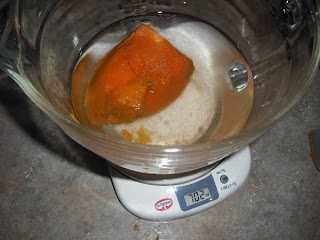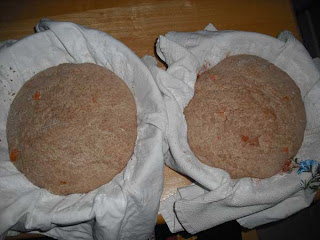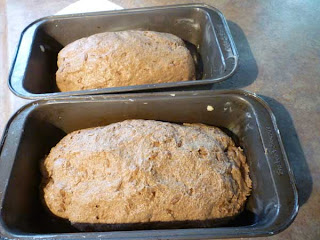Everyday breads
The last time I baked, I made about 6 or 7 loaves in one day. The details are a bit fuzzy now: I should have written it all down earlier, but here's what I remember.
1. Some millet bread
I added some millet flour (25%) to a whole wheat loaf made with Tartine methods and ended up with some very dense bread.
This actually was a boon, since my wife has been complaining that her jelly will not stay on the breads with the huge irregular holes. Honey also passes through when that other bread is toasted, and the honey warms enough to flow. So this millet bread turned out pretty well. I can only eat 1-2 slices at a time though, it is so filling.
I cracked into the first loaf while it was still warm.
2. SuperSourdough Bread
This started with an experiment with pizza, of all things. I had some old spent sourdough starter. Not overly old, but past its peak: Tartine-style breads call for young, vibrant wild yeast cultures, and this was about 8-10 hours past that peak. Still, I was once again tired of just tossing out my discards, and I decided to see if I could make a pizza with this one. I made some dough with my already-mixed Tartine flour
(a 50:50 mix of whole wheat and all-purpose that in the Tartine Recipes is used for starter. I no longer use this flour anymore for my wild yeast starter, opting instead to keep just one starter going, and since my interest is whole grains, my wild yeast culture is a 100% whole wheat starter at 100% hydration, with which I am now baking all my bread. Long story short: all this mixed flour was just sitting there no longer being used). I mixed all of the sourdough (not just 20% of the dough, so it was probably 40-45% of the final dough), and I let it sit before adding the salt, and maybe even gave it a turn or two. But then: I forgot about it until the evening. So it had an extra long bulk ferment, at room temperature, maybe 12-14 hours.
I made a pizza with half of the dough and it turned out okay, but it was
very sour tasting. I didn't toss the rest of the dough out, though. I refrigerated it, and again forgot about it for a day or two. Suddenly, there it was, and I could now toss it out or do something with it. I decided to bake it into a bread, knowing that it would probably turn out super-sour and even inedible, but something that perhaps the backyard chickens would eat and turn into eggs.
The sour dough was only out of the fridge long enough to shape and preheat the oven, so it was still quite cold when I put it into the dutch oven. At the very last moment, I also decided to drop on top of it a bit of fermented millet that I had been keeping in the fridge, to use it up. It too was past its prime, and too sour for ordinary use. But if I was just feeding this to the chickens, why not put it on top?
 |
| the dough proofing |
 |
| last minute idea was to add some refrigerated fermented millet on top of the proofed loaf when it hit the oven |
 |
| fresh from oven, still in dutch oven |
 |
| millet crust of a sour bread |
 |
| looks crunchy: but it isn't |
 |
| sour sour sour sour sour |
 |
| can't see where the millet begins |
 |
| weird loaf: different but not inedible |
This dough even smelled sour when it was baking. The finished loaf had a sour scent to it, and it looked awfully strange, with the millet on top giving it a very odd textured crust.
But wonder of wonders: the crust is not crunchy, it is soft. And the texture of the loaves is gentle. Yes, it is sour tasting, but the bread is not inedible. I actually quite enjoy it for a change of taste. And when you slice into it, you can't really see where the wheat dough ends, and the fermented millet begins. A very odd loaf, I admit, but quite a fun experiment.
The chickens got none of it.
2. Olive Bread
One of my co-workers was complaining that I hadn't made any olive bread recently, so I made up a sourdough bread with 85% whole wheat and 15% all purpose wheat flours. To this I just dumped in some drained Kalamata Olives that we had in the fridge (about 358ml). So it wasn't the official Tartine Olive bread.
 |
| two different doughs bulk fermenting: olive is on the right |
 |
| after dividing and baking: the olive loaves |
 |
| the olive loaf I tried to give away and ended up cutting into myself: lucky to get this crumb shot |
 |
| more holes than olives |
I gave one loaf away to my yoga instructor and her spouse, and was going to give another one to my coworker. But she wasn't working on the day I arrived with the loaf, and wouldn't be back for a couple of days. I decided to slice into it myself and share it with whoever else happened to want to try some. Very few of my coworkers even bothered to try it.
That's the thing, when I work with so many girls who are watching their figures and believe that not eating bread will help.
I can't give the stuff away.
I dragged the loaf home again, and my wife had a couple of slices. There was just a fraction of the loaf left when I dragged it to work one last time a couple of days later and gave it to the co-worker who had originally asked for it. She was grateful even for the tiny starting-to-stale crust that remained ("
You mean I can take the whole thing? Are you sure?").
3. Whole Wheat with 15% Rye
This was baked for me. I figured I'd need a couple of loaves of this, to get me through a 3-day weekend of working 12 hour shifts. But this bread is so filling, I really only required the one loaf. Today, now that the weekend is over and I can sit down and write about the breads I baked, I sliced into the second of these loaves for the first time. And it will last until the bread I bake today is ready to eat tomorrow, easily.
And that's the thing about whole grains, that still have all the fibre intact: you don't get fat on this bread, because this bread
satiates. Even with all the cheese and butter that I tend to use. And I believe it is because the sense of fulfillment lasts a long time. You don't feel hungry again after 20 minutes the way you do if you eat white bread. You don't get such a spike in insulin, a glucose rush in the bloodstream. It doesn't sit like a rock in your stomach, but you feel full longer. You won't want to gorge on this bread. But taste it, and you will want to eat it.
I try to tell my coworkers this, but some of them just don't get it. And why would they? They have no experience of it, because true whole grain bread is something that doesn't exist in the marketplace any more (unless you live within 10 minutes of an artisan baker, and lets face it, how many of us do? And so often even artisan bakers won't make truly 100% whole wheat bread without some bread flour. I've met with two different artisan bakers who told me "it is
impossible to make bread without some all purpose or bread flour").
 |
| impossible bread |
Furthermore, my bread is very suspicious looking to people who have never seen anything like it before. And the nurses I work with are taught by the hospital's
Lords of Infection Control that All Bacteria are All Harmful and must be eradicated with sterile procedures, frequent hand-washing, alcohol-based chlorhexidine scrubs, etc. In the hospital we try to be careful but nevertheless superbugs are growing that are hyper-resistant to antibiotics. Bacteria are evolving immunity to our drugs far faster than any antibiotic medicines can be made to destroy them, and the so-called superbugs especially thrive in hospitals that fastidiously remove with powerful cleansers their less evolved competition.
Bill Bryson writes of bacteria in his book, "A Short History of Everything":
"Given an adequate supply of nutrients, a single bacterial cell can generate 280,000 billion individuals in a single day... In the same period, a human cell can just about manage a single division.
About once every million divisions, they produce a mutant. Usually this is bad luck for the mutant -- change is always risky for an organism -- but just occasionally the new bacterium is endowed with some accidental advantage, such as the ability to elude or shrug off an attack of antibiotics. With this ability to evolve rapidly goes another, even scarier advantage. Bacteria share information Any bacterium can take pieces of genetic code from any other."
All the cleaning and hand-washing (hand-wringing, more like) leads to one inescapable conclusion: we can't win against bacteria. Not now, not ever. So we might as well learn how to get along with it (them). In fact, we couldn't live a moment without some of them (Bryson again: "
Microbes... supply the greater part of the planet's breathable oxygen..."). We only hear about the negative effects of some of them. Re-educating people about the positive benefits of some bacteria is sometimes difficult.
I tried to describe what was in my sourdough culture (wild yeast and lactobacilli bacteria) to a nurse that had recently graduated from nursing college. She wanted to know where my sourdough came from and I told her that I grew it myself from a mixture of water and flour, allowing it to ferment. I described the process, thinking she was fascinated by it, but I misread her interest. When she finally exhaled and told me that it sounded disgusting, I realized that her curiosity was similar to people who slow down at car-wrecks to survey the human wreckage.
This is the kind of uphill battle I fight when I try to describe to my coworkers what is in my bread and why I believe it is good for them, and even that it is safe for them to eat. My bread and the culture it is derived from is probiotic. This is living in concert with the bacteria that can't be eradicated. This is harmony with the unseen world around us. This is symbiosis with life that is nearer the source of the evolutionary tree than we are, life that is related to us and will support and sustain us if we do not neglect it.
My bigger fear is that I will bring home from the hospital some antiseptic, anti-bacterial cleanser on my hands and inadvertently destroy my sourdough culture that I have spent years developing.
Sandor Katz said it first and best in "Wild Fermentation":
"Your life and my life and everyone's lives and deaths are part of the endless biological cycle of life and death and fermentation. Wild fermentation is going on everywhere, always. Embrace it. Work with the material resources and life processes that are close at hand. As microorganisms work their transformative magic and you witness the miracles of fermentation, envision yourself as an agent for change, creating agitation, releasing bubbles of transformation into the social order. Use your fermented goodies to nourish your family and friends and allies. The life-affirming power of these basic foods contrasts sharply with the lifeless, industrially processed foods that fill supermarket shelves. Draw inspiration from the action of bacteria and yeast, and make your life a transformative process."
Amen to that, brother.
 |
| everyday breads |
|
Notes to Myself
- You can use older wild yeast starter if you don't mind a more sour loaf. I like it fine for a change once in a while.
- Millet that has been boiled, cooled, fermented and refrigerated turns into a sort of porridge. Coating a loaf with this cold, damp porridge yields a rustic crust that is soft and sour.
- 100% Whole Wheat Bread is possible. Sourdough and frequent gentle folding during the bulk fermentation is key to developing the gluten.
- Once in a while one likes to have a denser crumb, just to hold the jelly and honey.
- Stay close to the source of life. Believe in the culture that you develop from ingredients close at hand to make your bread.





































































